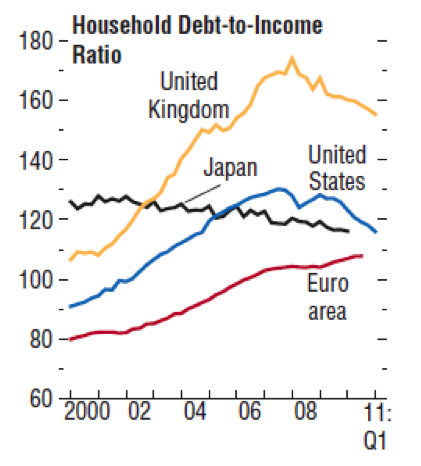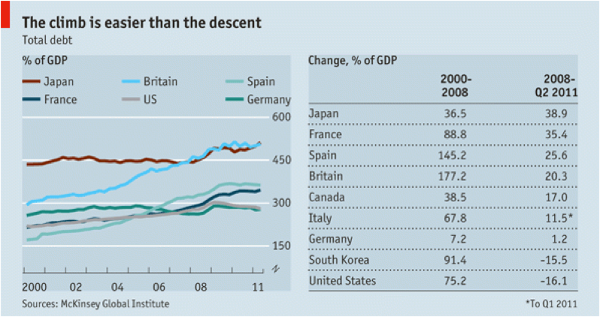The news from the United Kingdom this week implied that more quantitative easing and money printing is coming to the U.K. economy soon. When we take into account that high debt of households in the U.K., (see graph below) we could only come to one conclusion: deleveraging will take a long time in the U.K. economy and we anticipate a downward trend for the sterling pound.

Source: IMF World Economic Output, 2011
The US balance sheet is like a black hole. Everything goes in, but nothing comes out. The reason for this is that while any corporation would amortize its investments over a period of time through capital budgeting and the corresponding capital account, the US balance sheet fails to do exactly that, treating everything as a cash expense that does not add to the assets that build up the nation. The reality is that government accounting systems distort reality, overestimating expenditures in some cases and underestimating revenues – due to treatments of non-market asset buildup – in several other cases. R&D, innovation, human capital, flexibility, vision, and execution create competitive advantages that cannot be captured in accounting measures, especially ones that fail to account for capital (human, social, physical, legal, financial) formation.
In the mid 1980s everything was going right for Sony corporation, and almost everything was going wrong for Apple. Actually you needed twenty two Apple corporations to make up for one Sony corporation. Twenty five years later it takes twenty two Sony corporations to make up for one Apple corporation. Apple built up capital, while Sony consumed its capital, and missed the boat.
In the 1960s, two nations obtained their autonomy from the imperial British colonial power. Both of them had about the same population size and GDP per capita of about $2,200. One (Jamaica) decided to continue without imagination and capital formation. The other (Singapore) invested for the future and went on a course of capital formation that awakes dormant assets, creates wealth, sustains a middle class and advances winners at no one’s expense. Fifty years later, the capital formation in Singapore has paid off and the value-added has created its miracles. Jamaica’s income per capita is about $4,900 while Singapore’s is about $41,000.
The EU economies seem that they are left behind. The pressures they are facing are the symptoms of failing to create capital. The debt they accumulated allowed them temporary prosperity bought on credit. The prospects of deleveraging will slow down its growth and will become an impediment to innovation and imagination. The fact is that private debt, as the table below shows keeps growing, while in the US the debt decrease is significant.
We anticipate that the EU will be squeezed and will experience capital flight, while the US will become the hostess country of capital inflows and formation. This is one more data point to the optimistic analysis regarding US markets we have published recently.
Ode to capital formation!

